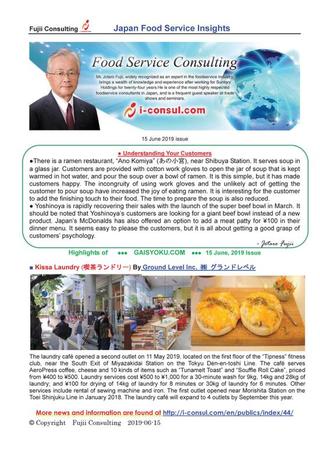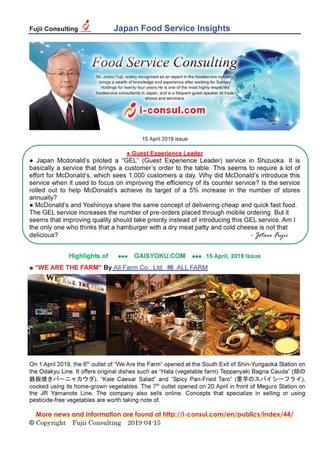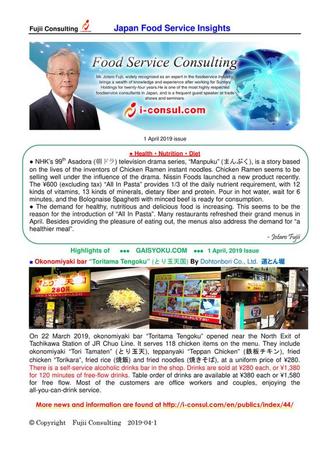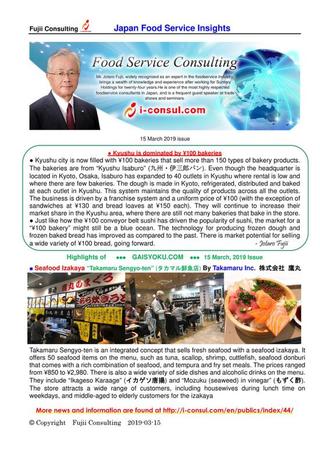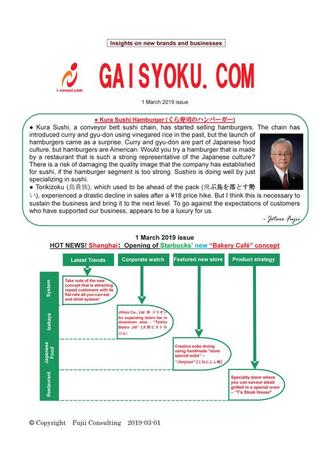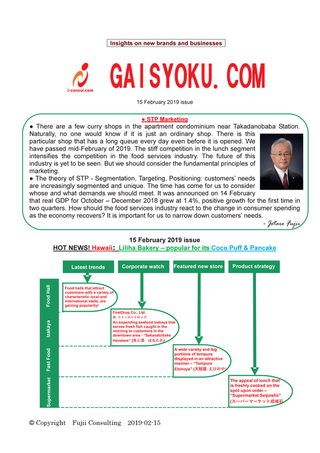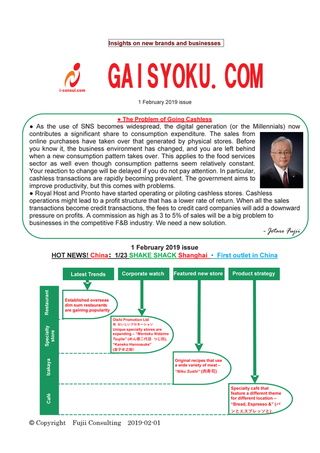i-consul.com|fujii jimusyo|food service consulting|restaurant business|Setagaya, Tokyo

http://i-consul.com/en/
GAISYOKU.COM (Issued twice monthly)
President's column(Serializing in GAISYOKU.COM)
President's column(Serializing in GAISYOKU.COM)
Understanding Your Customers
15-Jun-2019
● There is a ramen restaurant, “Ano Komiya” (あの小宮), near Shibuya Station.
It serves soup in a glass jar.Customers are provided with cotton work gloves to open
the jar of soup that is kept warmed in hot water, and pour the soup over a bowl of ramen.
It is this simple, but it has made customers happy.
The incongruity of using work gloves and the unlikely act of getting the customer to
pour soup have increased the joy of eating ramen.
It is interesting for the customer to add the finishing touch to their food.
The time to prepare the soup is also reduced.
● Yoshinoya is rapidly recovering their sales with the launch of the super beef bowl in March.
● Yoshinoya is rapidly recovering their sales with the launch of the super beef bowl in March.
It should be noted that Yoshinoya’s customers are looking for a giant beef bowl
instead of a new product. Japan’s McDonalds has also offered an option to add a meat patty
for \100 in their dinner menu. It seems easy to please the customers,
but it is all about getting a good grasp of customers’ psychology.
Expectations for Whale Meat
01-Jun-2019
● From July 2019, Japan will resume commercial whaling in its waters,
after withdrawing from the International Whaling Commission (IWC) last year.
It is food nostalgia for those who have tasted whale meat as part of their school lunches
in the 1960s.Meat consumption is expanding but fish consumption is decreasing.
The resumption of whaling is expected to bring about a new market of whale meat consumption.
Whale, as a mammal, has a taste and texture similar to beef. The consumption of Gibier cusine
(ジビエ料理 or wild game cuisine), such as deer and wild boar and mutton after the removal of
its distinctive smell, is increasing. Will whale meat be widely accepted?
A variety of recipes is likely to be developed for whale meat.
● The anti-whaling issue is an opportunity for us to think about the importance of food,
● The anti-whaling issue is an opportunity for us to think about the importance of food,
the guardian of all lives on Earth and the connector of human lives.
How will people accept whale meat in the present-day mature diet?
I, too, would like to have a taste of nostalgia again.
|
|
File ( 2094KB ) |
Changes in Consumption Pattern for Tapioca Milk Tea
15-May-2019
● Tapioca milk tea stores have, no doubt, created the highest number of queues since last year.
One cup of milk tea costs around \500. Queues of mostly middle- and high- school girls are seen
at all brands of tapioca milk tea. Women in their 20s and 30s are also ardent supporters of the drink.
You can get beef bowls and hamburgers at the same price. It looks like a boom,
but I see a change in consumption behavior happening in the background.
● It is said that the shift from mono (モノ, tangible) to koto (コト, intangible) consumption is getting
stronger, but the consumption of tapioca milk tea seems to be one of “experience consumption”.
It seems that the combination of “queuing up”, “uploading to Instagram” and “new taste and appearance”,
adds joy to daily life. There is a market that cannot be attracted just by offering low prices.
The era of food services that provide new forms of “experience consumption” is growing.
|
|
File ( 2094KB ) |
Omotenashi (Hospitality) with the use of IoT
01-May-2019
● It is less than 500 days to the opening of the Olympics. Ticket sales have commenced.
The world’s best face recognition technology developed by NEC, will be deployed at
the entrance checkpoints of the Olympics venues for security and speed.
the entrance checkpoints of the Olympics venues for security and speed.
Face recognition technology is already used in iPhone X and other products.
It is even used by food services operators. For example, a ramen chain is using
ticket vending machines with built in camera authentication system to disburse
tickets to customers who have subscribed to their meal packages.
ticket vending machines with built in camera authentication system to disburse
tickets to customers who have subscribed to their meal packages.
No payment or other procedure is required.
● NEC is pilot-testing “IoT Omotenashi” in Nanki Shirahama. The system uses QR code to
● NEC is pilot-testing “IoT Omotenashi” in Nanki Shirahama. The system uses QR code to
register facial information, credit card details, etc.
Tasks such as checking in at the airport, arranging for pick-up at the airport,
unlocking hotel rooms, shopping and dining, can all be done with through facial recognition.
A new style of “convenient and comfortable”omotenashi is expected to emerge from the Olympics.
|
|
File ( 2094KB ) |
Guest Experience Leader
15-Apr-2019
● Japan Mcdonald’s piloted a “GEL” (Guest Experience Leader) service in Shizuoka.It is basically a service that brings a customer’s order to the table.This seems to require a lot of effort for McDonald’s, which sees 1,000 customers a day.Why did McDonald’s introduce this service when it used to focus on improving the efficiency of its counter service? Is the service rolled out to help McDonald’s achieve its target of a 5% increase in the number of stores annually?
● McDonald’s and Yoshinoya share the same concept of delivering cheap and quick fast food.
The GEL service increases the number of pre-orders placed through mobile ordering.But it seems that improving quality should take priority instead of introducing this GEL service.
Am I the only one who thinks that a hamburger with a dry meat patty and cold cheese is not that delicious?
|
|
File ( 2094KB ) |
Health・Nutrition・Diet
01-Apr-2019
●NHK’s 99th Asadora (朝ドラ) television drama series, “Manpuku” (まんぷく),
is a story based on the lives of the inventors of Chicken Ramen instant noodles.
Chicken Ramen seems to be selling well under the influence of the drama.
Nissin Foods launched a new product recently. The ¥600 (excluding tax)
“All In Pasta”provides 1/3 of the daily nutrient requirement, with 12 kinds of
vitamins, 13kinds of minerals, dietary fiber and protein.
Pour in hot water, wait for 6 minutes,and the Bolognaise Spaghetti with minced
beef is ready for consumption.
● The demand for healthy, nutritious and delicious food is increasing.
This seems to be the reason for the introduction of “All In Pasta”.
Many restaurants refreshed their grand menus in April.
Besides providing the pleasure of eating out, the menus also address the demand
for “a healthier meal”.
|
|
File ( 2094KB ) |
Kyushu is dominated by \100 bakeries
15-Mar-2019
● Kyushu city is now filled with \100 bakeries that sell more than 150 types of bakery products.
The bakeries are from “Kyushu Isaburo” (九州・伊三郎パン).
Even though the headquarter is located in Kyoto, Osaka, Isaburo has expanded to 40 outlets in Kyushu
where rental is low and where there are few bakeries.
The dough is made in Kyoto, refrigerated, distributed and baked at each outlet in Kyushu.
This system maintains the quality of products across all the outlets. The business is driven by a franchise
system and a uniform price of \100 (with the exception of sandwiches at \130 and bread loaves at \150 each).
They will continue to increase their market share in the Kyushu area, where there are still not many
bakeries that bake in the store.
● Just like how the \100 conveyor belt sushi has driven the popularity of sushi, the market for a
“\100 bakery” might still be a blue ocean. The technology for producing frozen dough and frozen
baked bread has improved as compared to the past.
There is market potential for selling a wide variety of \100 bread, going forward.
|
|
File ( 2094KB ) |
Kura Sushi Hamburger
01-Mar-2019
●Kura Sushi, a conveyor belt sushi chain, has started selling hamburgers.
The chain has introduced curry and gyu-don using vinegared rice in the past,
but the launch of hamburgers came as a surprise.
Curry and gyu-don are part of Japanese food culture, but hamburgers are American.
Would you try a hamburger that is made by a restaurant that is such a strong representative of
the Japanese culture? There is a risk of damaging the quality image that the company has
established for sushi, if the hamburger segment is too strong.
Sushiro is doing well by just specializing in sushi.
● Torikizoku (鳥貴族), which used to be ahead of the pack (飛ぶ鳥を落とす勢い), experienced
a drastic decline in sales after a \18 price hike. But I think this is necessary to sustain
the business and bring it to the next level.
To go against the expectations of customers who have supported our business, appears to be a luxury for us.
|
|
File ( 2094KB ) |
STP Marketing
15-Feb-2019
●There are a few curry shops in the apartment condominium near Takadanobaba Station.
Naturally, no one would know if it is just an ordinary shop. There is thisparticular shop that
Naturally, no one would know if it is just an ordinary shop. There is thisparticular shop that
has a long queue every day even before it is opened. We have passed mid-February of 2019.
The stiff competition in the lunch segment intensifies the competition in the food services industry.
The future of this industry is yet to be seen. But we should consider the fundamental principles of
marketing.
● The theory of STP - Segmentation, Targeting, Positioning: customers’ needs are increasingly
marketing.
● The theory of STP - Segmentation, Targeting, Positioning: customers’ needs are increasingly
segmented and unique. The time has come for us to consider whose and what demands we should meet.
It was announced on 14 February that real GDP for October – December 2018 grew at 1.4%,
positive growth for the first time in two quarters. How should the food services industry react to the change in consumer spending as the economy recovers? It is important for us to narrow down customers’ needs.
|
|
File ( 1759KB ) |
The Problem of Going Cashless
01-Feb-2019
●As the use of SNS becomes widespread, the digital generation (or the Millennials) now contributes a significant share to consumption expenditure.The sales from online purchases have taken over that generated by physical stores. Before you know it, the business environment has changed, and you are left behind when a new consumption pattern takes over.This applies to the food services sector as well even though consumption patterns seem relatively constant.Your reaction to change will be delayed if you do not pay attention. In particular, cashless transactions are rapidly becoming prevalent. The government aims to improve productivity, but this comes with problems.
● Royal Host and Pronto have started operating or piloting cashless stores. Cashless operations might lead to a profit structure that has a lower rate of return.When all the sales transactions become credit transactions, the fees to credit card companies will add a downward pressure on profits.A commission as high as 3 to 5% of sales will be a big problem to businesses in the competitive F&B industry. We need a new solution.
|
|
File ( 2053KB ) |



